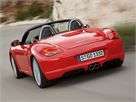Recent Articles
Popular Makes
Body Types
10 Things You Should Know About the 2010 Porsche Boxster
There’s no denying good genes
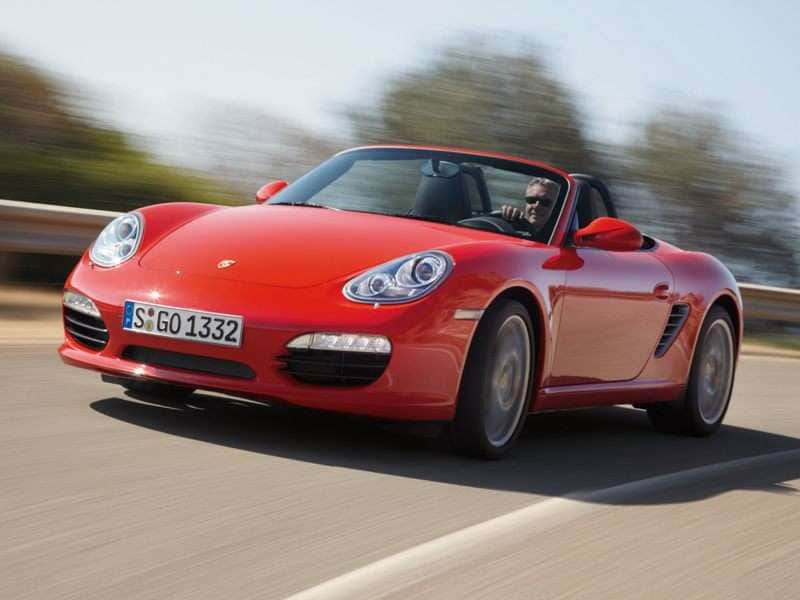
2010 porsche boxster red convertible
Sometimes life gives you a break, skipping right over the giving of lemons and surprising you with a full glass of lemonade instead. That’s the feeling one of our editors had when presented with a Porsche Boxster S and a sunny autumn day in New England. With his girlfriend at his side and a free Saturday to head west through Maine’s apple-picking country en route to the base of the White Mountains, he set out to enjoy the scenery and experience everything Porsche’s drop-top had to offer.
After hours of opting for roads less traveled (many of which were twisty and deserted) and seeing the sun begin to set, they found themselves at a rural drive-in that was hosting its last show of the season. As the credits rolled, they hit the eastbound Interstate, with the heater and heated seats on high and the clear sky above.
The day could’ve been equally memorable in another ride, but that’s doubtful. It’d have to offer the same raspy bark as the Boxster S, the same tight handling and smooth power along those curvy back roads, and as far as the girlfriend was concerned, it’d still have to be named Porsche.
#10. With the heavy lifting done in 2009, the 2010 Boxster arrives with few changes.
Porsche upgraded its entry-level model for the 2009 model year, though purists were relieved to discover that the changes didn’t include any dramatic massaging of the car’s familial lines. The Boxster’s exterior styling was altered ever so slightly with tweaked front and rear treatments, while the interior was dressed up with a voice-activated communications system sporting a 6.5-inch touch screen. More importantly, the 2009 Porsche Boxster ushered in a duo of improved engines and transmissions.
For 2010, the German two-passenger drop-top has been treated to a few more enhancements, including a three-spoke heated steering wheel and a Dark Blue Metallic paint color. Behind the scenes are suspension refinements and a new standard tire engineered to improve ride and handling characteristics.
A more significant contribution is the 2011 Porsche Boxster Spyder, a model that launched earlier this year, representing what is the most aggressive of the lineup’s offerings.
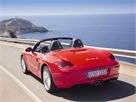
#9. German convertible fun - even of the entry-level variety - doesn't come cheap.
Shoppers interested in the Porsche’s entry-level Boxster have two versions from which to choose. The base model, referred to simply as the Boxster, carries a starting price of $47,600. Shell out nearly 48 grand and in return you’ll get a list of standard features that includes a power rear spoiler, leather upholstery and trim, front and rear fog lights, cruise control, and a basic audio system with a single-disc CD player. Power comes from a 2.9-liter six-cylinder engine paired with a six-speed manual transmission.
A jump up to the Boxster S will avail buyers to not only a 3.4-liter six-cylinder – and that same six-cog gearbox – but also 18-inch alloy wheels in lieu of the base model’s 17s and a more aggressively tuned suspension. Prices start at $58,000.
This article focuses on the 2010 Boxster, but we’ll also take a minute to mention the $61,200 Porsche Boxster Spyder, a 2011 model that was launched earlier this year. Motivation comes from a gutsier version of the S’s 3.4-liter engine, while a lowered suspension and weight savings (granted by the absence of a standard radio and air-conditioning system) serve to make the Spyder a ready-for-the-track car. The old-school cloth top isn’t for those of us who enjoy quick and easy convertible operation, and the fabric interior door pulls look cool but will have you longing for a traditional handle after a short while.
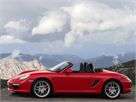
#8. For every Euro, there is a Boxster option.
Since this is a Porsche, shoppers just might want to zero in on options designed to take full advantage of the brand’s sporting heritage. Among them is Porsche Active Suspension Management (PASM), which lowers the ride height and electronically responds to how fast and hard the car is being driven; a sport exhaust system; ceramic composite brakes; and a Sport Chrono Package Plus engineered to deliver optimum acceleration with its launch control feature. Also available are heated and ventilated seats, and comfort and convenience amenities such as a Bose audio unit as well as the Porsche Communication Management and navigation combo.
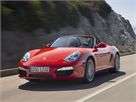
#7. Comfort is relative. And not all that abundant in the Porsche Boxster.
Just by looking at the 2010 Porsche Boxster – a low-slung, soft-top sports car – you might assume that comfort isn’t this ride’s strong suit. And, to be sure, there are certainly models out there that take coddling to an entirely different level, but that doesn’t mean miles traveled in this German two-door must necessarily be followed by a trip to your chiropractor.
Admittedly, the Boxster S’s suspension is stiff and entry and exit are a bit problematic for those of us who aren’t quite as limber as we were in our younger days. But once you plop your rear end onto the bucket seats you’ll find supportive padding, ample side and upper bolsters, and a soft, leather-wrapped tilt and telescoping steering wheel that lets you dial in a personalized fit. Our five-foot-eight-inch-tall editor was granted sufficient leg room, but the Boxster’s width felt a smidge confining in terms of shoulder and hip space.
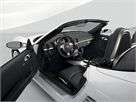
#6. A bit of advice: Travel light and fill up on fluids prior to departure.
There are certain sacrifices that come with relying on the 2010 Boxster as your daily driver. First and foremost is the lack of cargo space. Granted, 9.9 cubic feet doesn’t sound all that bad for a sporty two-seater, but keep in mind that we’re talking about a combined total; the deep but narrow well under the hood offers 5.3 cubic feet of space, with the remaining 4.6 cubic feet available in the rear trunk. We were able to fill the former with a carry-on suitcase, but nothing more than a couple of stuffable backpacks in the latter. Interior storage includes a bit of room behind the seats for jackets or a small bag, a couple of small slots and cubbies, and cupholders that awkwardly pop out of the passenger-side dash.
The Boxster’s controls and instrumentation are a combination of simplicity and user-unfriendliness. Among the praiseworthy bits are the uncluttered gauge cluster and well-labeled buttons for basic climate and audio functions. Things turn off the intuition highway when considering the nameless dials and tabs associated with the touch-screen display.
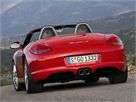
#5. Going topless at up to 30 mph.
Bucking the retractable hardtop trend due to weight savings, the 2010 Porsche Boxster continues to feature a cloth roof. The top is lowered and raised automatically at the touch of a button, a process that Porsche claims can be done at speeds up to 30 mph. The whole package stows neatly under a panel just behind the cockpit.
Before any of that can be done, drivers must turn a large handle that locks the roof into the top of the windshield frame. This isn’t what we’d call an arduous task, but it seems like an old-school and out-of-place step given the fact that convertibles costing thousands less come standard with fully automatic units.
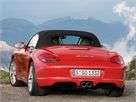
#4. Power and fuel economy. It's the new Brad and Angelina.
Mounted mid-ship is the 2010 Porsche Boxster base model’s 2.9-liter six-cylinder engine, an all-aluminum mill that’s good for 255 horsepower at 6,400 rpm and 214 lb.-ft. of torque available between 4,400 and 6,000 rpm. The rear 17-inch alloy wheels are driven by a standard six-speed manual transmission or an optional double-clutch seven-speed unit called Porsche Doppelkugglungsgetriebe. You may not be surprised to learn that the company simply refers this as PDK. When equipped with that oddly named tranny, the EPA suggests drivers will see an average of 20 mpg around town and 29 mpg on the highway, all while burning premium fuel. Opt for the stick-shift gearbox and those figures drop to 19 mpg/27 mpg, respectively.
The sportier Boxster S gets its muscle from a 3.4-liter six-shooter with direct injection and boasting 310 horses at 6,400 rpm backed up by 266 lb.-ft. of twist between 4,400 and 5,500 rpm. Transmission choices mirror those of the base Boxster, but the standard rollers measure 18 inches. With the exception of a 26-mpg highway rating for the manual-equipped Boxster S, and despite the bump in power and displacement, fuel economy matches that of the smaller engine.
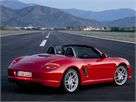
#3. Illicit drugs can't hold a candle to the addictive nature of a 7,500-rpm redline.
There’s something about the sound of a Porsche boxer engine, one that can be heard only after turning the ignition key to the left of the steering wheel. It made us thankful for favorable weather and the opportunity to let the raspy rumble enter the interior without being shut out by the soft top and its surprising ability to stifle the cacophony of the outside world.
But, let’s get to the driving.
Throttle response is smooth and linear, making the Boxster S feel calm and collected for slow, around-town slogs. When the road opens up, hammer down and the 310-horsepower horizontal six delivers power quickly and evenly all the way up to its 7,500-rpm redline. Torque is plentiful enough that you don’t have to run the engine ragged, but we soon found ourselves addicted to the sound and sensation of doing just that. When it is time to shift, your left foot greets an easily-modulated clutch collaborating with a manual tranny offering less precision than we’d expected.
According to Porsche, a model like our six-speed Boxster S, weighing in at roughly 3,000 pounds, should reach 60 mph in five seconds flat, or 4.7 seconds if you’ve opted for the PDK and Sport Chrono Package Plus. Top speed is a cool 170 mph.
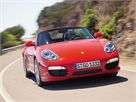
#2. Optimum comfort is the price you pay for genuine sports-car handling.
After a day spent driving the Boxster S in the city and along our often-traveled highway commute, we started to wonder how sore our backs would be after the coming week of testing. First impressions marked the Porsche convertible as a ride rolling on a decidedly stiff chassis.
That perspective changed as the time went by, a shift we attribute to either acclimating to the new driving environment or, more likely, involuntarily focusing on the car’s entertainment value. A grip of the steering wheel served to fill us in on the communication between the Boxster and the road, and our input resulted in immediate response. The greatest degree of fun came at every opportunity to nail the throttle exiting a corner, with the outside rear tire taking hold and the body staying flat throughout the turn.
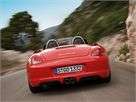
#1. Good job, Junior. You're living up to the family name.
Some folks knock the Boxster for being a poor man’s Porsche, a model that dilutes the German brand’s heritage of exclusive, high-end sports cars. Hmm. If being in a position to buy a $50-60,000 vehicle makes one poor, let us be among the first to sign up for the next “10 Steps to Becoming Poor!” seminar.
No, the Boxster is not the 911. But as we discovered, the S version is a car that delivers unmistakable Porsche styling, a powerful and smooth boxer engine complemented by a solid and capable chassis, and the understated luxury and refinement characteristic of its big brother. The questionable level of hospitableness could be considered a flaw to shoppers looking for a comfy cabriolet, but for those who dream of slicing and dicing twisties, its all part of the appeal.
